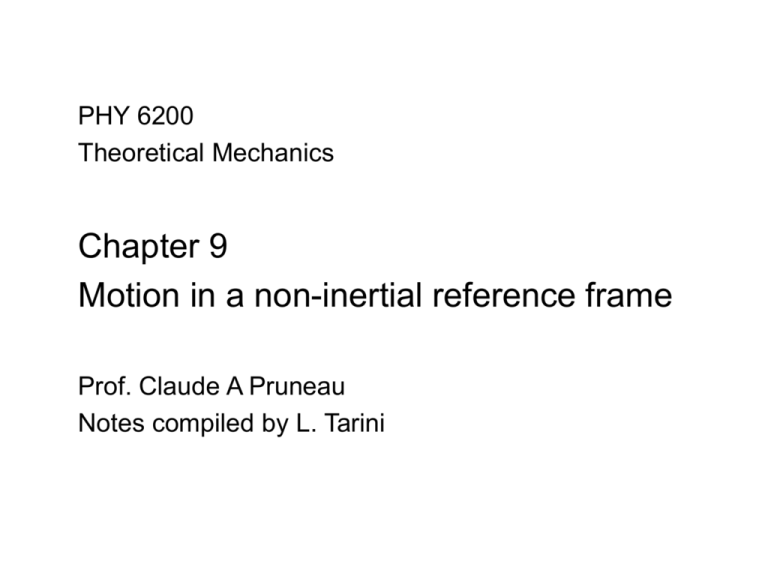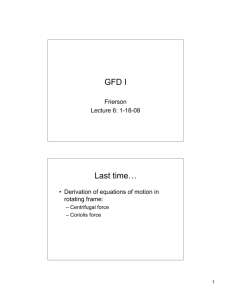Chapter 10
advertisement

PHY 6200 Theoretical Mechanics Chapter 9 Motion in a non-inertial reference frame Prof. Claude A Pruneau Notes compiled by L. Tarini Introduction • Sometimes it is simply easier to write equations in a non-inertial reference frame. – E.g. Motion near the surface of the Earth • A non inertial reference frame Rotating coordinate systems x3 x3 x2 R x 2 x1 Fixed system r P r x1 Rotating system r r r R r First consider a fixed point in the rotating frame x 3 x3 x2 R x1 x 2 r P r x1 r r r dr fixed d r r r d r r r dr r r dt fixed dt Next, consider a moving point in the rotating frame Motion of the point in the rotating frame: r dr dt rotating Motion of the point in the fixed frame: r r r r dr dr r dt fixed dt rotating Consider r x1ê1 x2 ê2 x3ê3 in rotating system Assume fixed and rotating system have same origin r d dr xi êi dt fixed dt i ˆi x&i êi xi e& i r& xi êi ri in the rotating system i r r& dr ˆi rr xi e& dt fixed i Example: Consider a d rotation about the 3-axis. dê1 d 3ê2 3 x2 d 3 3 dt dê1 d 3 ê2 dt dt ê1 x1 dê1 dê1 3ê2 dt Similarly consider a d rotation about the 2-axis. x3 dê1 d 2 ê3 x2 2 ê1 x1 dê1 d 2 2 dt dê1 d 2 ê3 dt dt dê1 2 ê3 dt dê1 3ê2 dt dê1 2 ê3 dt dê1 3ê2 2 ê3 dt Similarly dê1 3ê2 2 ê3 dt dê2 3ê1 1ê3 dt dê3 2 ê1 1ê2 dt Conclusion r & eˆi êi r r& r& r r dr & rr xi eˆi rr r dt fixed i The result is valid for any vector. r r dQ dQ r r Q dt dt rotating fixed Note that , the angular acceleration, is the same in both systems. r r r r r d d d dt fixed dt rot dt rot r& r r dr dR dr dt fixed dt fixed dt fixed dR dt fixed r r r dr r dt rotating Now define Conclusion r r& dr v f rf dt fixed r r r& dR v Rf dt fixed r r r& dr vr rr dt rotating r r r r v f v vr r Acceleration r F ma is valid only in inertial frames r dv f r F ma f m dt fixed r r r r v f v vr r r dv f dt fixed r r r r& r r dr dv dvr r dt fixed dt fixed dt fixed r dv f dt fixed r r r r& r r dr dv dvr r dt fixed dt fixed dt fixed Rf r r r dvr vr dt rot r r ar vr The last term r r r dr r r r dr r dt fixed dt rot r r r r r vr r Finally… r& r& r r r r r r r r & F ma f mR f mar m r m ( r ) 2m vr For an observer in the rotating coordinate system r r Feff mar (Newton's 2nd law) r r& r& r r r r r r F mR f m r m ( r ) 2m vr Sum of the forces acting on the particle as measured in the fixed (inertial) frame Translation + angular acceleration Centrifugal Force Coriolis Force Centrifugal and Coriolis forces are not forces in the usual sense of the word. They are pseudo-forces introduced by our desire to write r Feff mar We thus have: r Feff ma f (non inertial terms) The Centrifugal Term Magnitude: r r r m ( r ) m r Direction: 2 r r r r ( r ) rr r m ( r ) r Directed outward Example 2 Hockey puck on a large merry-go-round (M-G-R) with a smooth frictionless horizontal flat surface Assume M-G-R has constant angular velocity rotating clockwise (seen from above). a) Find the effective force on the hockey puck after it has been given a push. b) Plot path r r r r r Solution: Feff m ( r ) 2m vr Neglecting friction; vr measured by observer on rotating surface. aeff r Feff r r r r r ( r ) 2 vr m r veff aeff dt r reff veff dt Assume the puck is initially at (0.5R, 0) Initial velocity Motion relative to the Earth z z In the fixed inertial frame r r F s mgo y x r y x External forces Gravitational attraction me g0 G 2 êr R along a radius Assume the Earth is a perfect sphere and neglect the fact g 0 varies because of oblateness, density, nonuniformities, altitude changes, etc. r& r r r r r r r r & & Feff s mg0 mRf m r m ( r ) 2m vr r let be along +z 7.3 10 rad s 5 Practically constant in time r So we neglect r dRr & Rf Rf dt 14 2 43 0 r r r R r r r r r r r r r Feff s mg0 m r R 2m vr 1 4 4 4 42 4 4 4 43 r g effective r r r r r g g0 r R 1 4 44 2 4 4 43 centrifugal Since near the Earth r = R, the centrifugal force r is dominated by R r The centrifugal force is responsible for the oblate shape of the Earth. Earth is deformed • Equatorial radius is +21.4 km > polar radius g 0.052 m 2 at the pole relative to the equator s • On a calm ocean, the water is perpendicular to g , not g 0 r r r ( r ) g0 g • In simpler terms r r r r Feff s mg 2m v f • Effective g (Pendulum period + direction of equilibrium) • 2 R 0.034 m s 2 about 0.35% of g0 Coriolis Force Term r r 2m vr Magnitude 2m 2 r north Direction r vr vr r r 2m vr Deflected path to the right of the particle motion Basics Properties of the Jovian Planets Planet Distance (AU) Period (years) Diameter (km) Mass (Earth=1) Density (g/cm3) Rotation (hours) Jupiter 5.2 11.9 142800 318 1.3 9.9 Saturn 9.5 29.5 120540 95 0.7 10.7 Uranus 19.2 84.1 51200 14 1.2 17.2 Jet stream flows eastward 30.1 Jupiter 164.8 ~ 300 km/h 49500 : speed Saturn : speed ~ 1300 km/h 17 1.6 16.1 Neptun e zones – upwelling air,capped by white ammonia cirrus clouds – top of enormous convection current. Darker zones – cooler atmosphere – downward motion – complete convection cycle. Light Example: Find horizontal deflection of a plumb lines caused by Coriolis effect for a particle falling from height “h” êz êy Solution: s0 r Feff mar r r r r ar g 2 vr êx x cos y 0 x0 y& 0 z sin z& gt Initially… êx êy êz r v f cos o sin gt cos êy o o gt g (0, 0, g) r arx 0 r ary 2 gt cos r arz g 1 y(t) gt 3 cos 3 1 2 z(t) z(o) gt 2 t 2h g y 0; y& 0 at t 0 1 8h 3 1 8h 3 d g cos cos 3 3 g 3 g Ex 5 Pendulum Precession (Foucault pendulum) z Small oscillations l y T Ty x Tx x Tx T l y Ty T l Tz T QuickTime™ and a TIFF (Uncompressed) decompressor are needed to see this picture. http://www.astro.louisville.edu/foucault/ r r r r T ar g 2 vr m z l x cos y 0 y T z sin gx 0 gy 0 Tx Ty x gz g & (vr )y y&, (vr )z z& 0 (vr )x x, êx êy êz r vr cos 0 sin x& y& 0 r vr ( y& sin , x& sin , y cos ) T ax m T ay m x 2 y& sin l y 2 x& sin l x 2 x 2 z y& & y& 2 y 2 z x& & (x iy) 2 z (ix& y&) (& x& i& y) 2 2 zi( x& iy&) Let q x iy 2 & q 2i z q q 0 That’s a damped oscillator! Except we have an imaginary term. The solution is thus: q(t) exp(i zt) A exp( z2 2 t) B exp( z2 2 t) if z 0 thus then ? z q 2 q 0; z 0 oscillation frequency q(t) ei z t (Aei t Bei t ) q(t) q(t)e i z t rotation (precession) x(t) x cos z t y sin zt y(t) x sin z t y cos z t x(t) cos y(t) sin sin x (t) with cos y(t) zt






